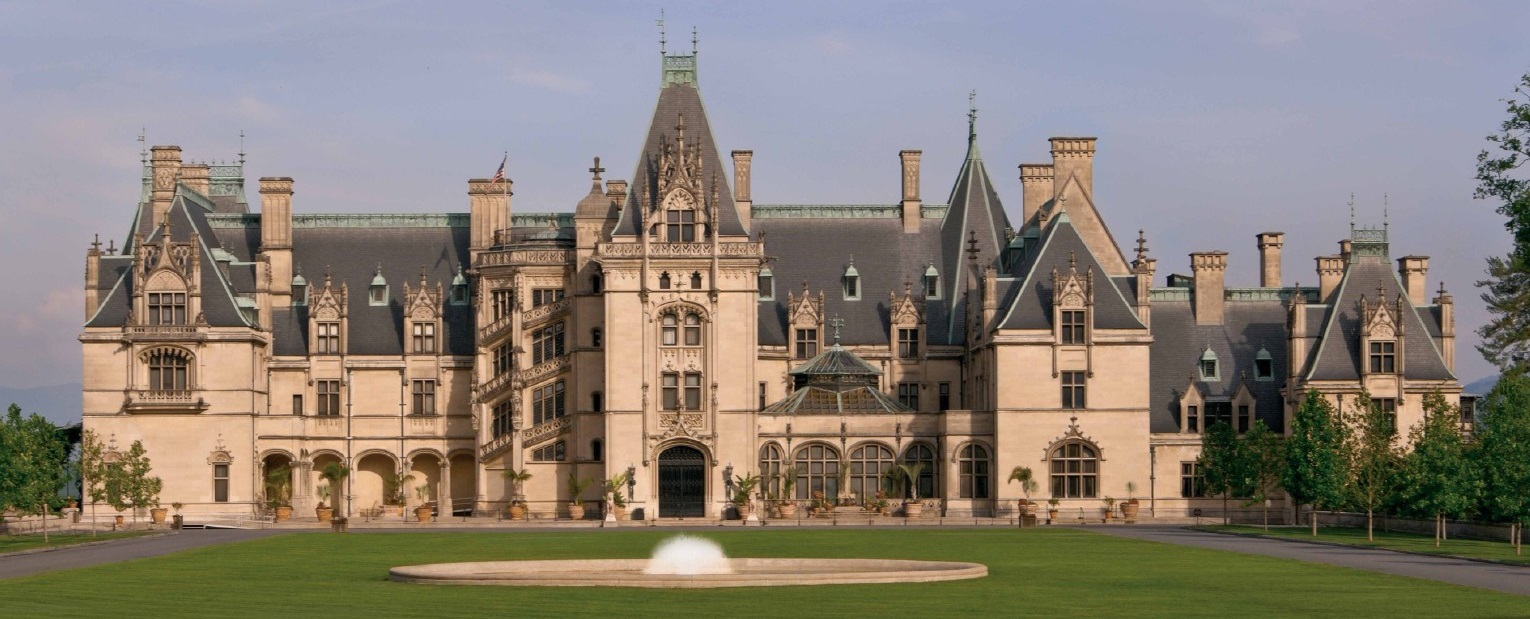It’s been called a “rising american nobility.” The post-Civil War decades saw rising industrial fortunes that created a new class of super-rich people the likes of which the republic had never seen. It spawned a leisure class eager for distinction and social standing.
Some of the new American millionaires fell, delightedly, upon the notion that they were, somehow, the new world equivalent of the European titled aristocracy. So they took up the pleasures of the earls and the barons, forming exclusive clubs, taking up golf and cultivating a gentleman’s taste.
Some sought the country life, acquiring landed estates and indulging in gentlemanly farming. In an America becoming more and more urban and industrial, wilderness landscapes, and the countryside in general, took on special meaning.
Between about 1875 and 1915 there occurred a broad movement to create rural estates and model farms. It was viewed by the opinion makers of the day as a positive phenomenon, imbued with the feeling that contact with nature could promote moral development and give a spiritual charge.
Of the many country estates created during these years, George Washington Vanderbilt’s Biltmore in Asheville, North Carolina is the most regal. Indeed, Biltmore House, with 255 rooms, is the largest private home ever built in America.
Asheville, set in the wilds of the Carolina piedmont, might seem an unlikely place to find a palace. For much of the 19th century the mountain community had been a haven for southern planters escaping the stifling summer heat. Vanderbilt never fully explained why he chose this place to create his personal pastoral utopia.
He first came to Asheville in 1888 and was quite taken with the landscape and its “distant scenery.” He began to acquire land with, as he admitted, no “definite end in view.” In time, he acquired over 600 parcels.
To assess his new princely holding, Vanderbilt called upon a friend, Frederick Law Olmsted, known as the father of American landscape architecture. Vanderbilt told him: “Now I have brought you here…to tell me if I have been doing anything very foolish.”
Olmsted surveyed the property and, in a 36-page report, broke the news. The land was poor, worn out by generations of subsistence farming and grain and tobacco cultivation — not suitable “for anything that can…be called park scenery.” He recommended against a gentlemanly “hobby farm,” for “what passes…as ‘gentleman farming’ is…a very costly and…unsatisfactory amusement.”
Instead, Olmsted proposed capitalizing upon the estate’s abundant forests for the scientific production of timber as a renewable resource, an innovation at the time that ultimately became the model for modern timber management.
But Olmsted also had to provide an enjoyable country house experience for Vanderbilt and his guests. Olmsted favored the gently meandering, naturalistic English picturesque garden tradition over the formal, symmetrical manicured-hedge parterres of the European Baroque.
He planned a sinuous, serpentine approach drive designed to convey “a wild and secluded character” with “no distant views,” no “obvious art.” Emerging from this the visitor would experience a surprise as the drive opened to a level spacious court and pleasure ground, with the great house beyond.
The house was placed so as to block the view of the mountains to the west. Upon traversing the house, the visitor would experience another surprise: the majestic mountains revealed in their glory.
The broad setting was meant to look uncultivated and wild, even thought it was artfully contrived. And, importantly, the house itself would have a role in telling the greater story of the unfolding idyllic landscape.
To fashion the house, George Vanderbilt turned to another acquaintance, Richard Morris Hunt, the leading American society architect of the later 19th century.
Hunt was the first American to be trained at the prestigious Ecole des Beaux Arts in Paris, the French national school of architecture. He is said to have spoken French like a Frenchman, without any trace of an accent, and cultivated a most refined persona.
Steeped in the Beaux Arts tradition of the glories of the European past, Hunt could render a convincing design in any period or style his client could desire. And for him the client’s choice was paramount.
“Remember,” he told a young associate, “it’s his money you’re spending.” And the choices were many: Gothic, Greek, Tudor, etc.
In developing Biltmore House, Hunt first proposed an agreeably rambling residence in the Colonial Revival style. He subsequently recast the design as a Tudor manor house, with essentially the same floor plan. After Hunt and Vanderbilt toured England and France together, in the summer of 1889, they settled upon early French Renaissance as the style of choice.
The whole idea of choosing a particular architectural style, like ordering from a menu, dates from the mid-1700s. It came about through a new understanding of change and time. The broad thrust of the Renaissance had been to bring back the art, architecture and civilization of ancient Rome and banish the “vulgarities” of the Middle Ages. But by the middle of the 18th century, archaeological discoveries and learned study of the past brought about a sea-change in fashionable opinion in the arts.
History was not the rebirth of a glorious civilization, moving ever upward. Rather, it was a series of separate and distinctive epochs: ancient Greece, Rome, the Middle Ages, and so on. The noted British architectural historian Sir John Summerson denoted this new ordering of things crisply — “distinct compartments.” And each epoch produced its own distinctive art and architecture. So the history of architecture was not the enlightened search for the most perfect (mostly Roman) classical style.
It was now seen as a series of equally valid styles: Egyptian, Greek, Roman, Gothic and so on. And this was the abiding spirit that drove the numerous popular historic revival styles one begins to see towards the end of the 18th century and beyond.
This may seem an arcane point, to be consigned to the dry and stuffy cloisters of academic debate, but it was a momentous change in the history of art. Imagine designing a 500 BC (looking) Greek temple for a bank, a 13th century (looking) Gothic style church, and a 17th century (looking) Italian villa for a residence, all in the same community by the same architect. It would have shocked and bewildered the fine sensibilities of Renaissance man. The art world, in the emerging 19th century, was a world of styles.
Biltmore House exemplifies a very special chapter in the annals of revival styles in America.
In the later 19th century there arose an increasing feeling for the sensitive, respectful and true rendition of historic forms. Among the high art circles of the day it was known as “scientific eclecticism.”
A rising generation of academically trained architects labored like scholars over the pedigree of building forms and features. Carefully composed designs were executed in fine materials with admirable workmanship. A vital component was lifting individual features from venerable antique buildings and incorporating them into new designs — a tower, a colon- nade, a portal. In this rarefied world, quotation from landmarks of the past was a cachet and a sign of cultivation, rather than poverty of invention.
Biltmore House is a very thoughtful essay in the early French Renaissance, generally demarked as the reigns of Kings Charles VII, Francois I and Henry II. During these years Classical Roman forms being revived in Renaissance Italy, filtered into France, rather in bits and pieces. Along with surviving Gothic elements, they coalesced into a resplendent style. It was an architectural flowering — rich, ornamental and very French. Its legacy includes many of the celebrated glittering chateaux of the Loire.
Biltmore House is a very graceful bow to this unique epoch in French art and design. It is a brick, concrete and iron structure clad in six inches of extraordinarily carved limestone. Its many interiors are jewel boxes of art, precious materials and splendor, and, for a late Victorian residence, surprisingly restrained and tasteful.
Biltmore House is surely the ultimate historic revival style residence in America. Famed 19th- century society critic Montgomery Schuyler felt that Biltmore was Richard Morris Hunt’s greatest work in a rural estate. It has a stately presence that complements the “noble and primeval landscape which it commands.”
To him, Biltmore “was an opportunity…unequaled on this side of the ocean — and indeed upon the other, since the old chateaux…were composed piecemeal…and not in a single stroke — he (Hunt) has taken advantage of it to produce a result…in its kind unequaled.” Taken as a whole, the Biltmore Estate is a symphony in architecture and landscape design.
It is, in short, a masterpiece, much as befits the rising American nobility.







